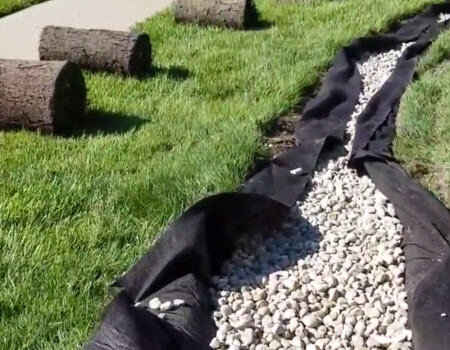How to Install a French Drain: Burrito wrap it!
In last week’s blog post , we answered the questions, “what is a french drain?” and “how can I fix standing water in my yard and basement?” and left you with the promise of best practices guidelines for the handy few who want to DIY install a french drain. Let’s dig right in! (Bad pun intended.)
Start by determining two areas. The first area you need to determine is the area that you want the water to move away from. The second area you need to determine is the area that you want the water to flow towards.
Next, you are going to dig the trench.
The trench will begin at the area you want the water to leave, and continue pitched downwards until it reaches the area you want the water to arrive at. To determine the pitch of the slope, the standard ration of one inch for every eight feet is typically recommended.
To ascertain the correct angle, tie a level string between two stakes, and measure the distance from that reference point to the bottom of the trench.
This part is very important: be positive that your trench is greater than twelve inches wide. Ideally, you should strive for a depth of between eighteen and twenty-four inches. The reason for this is that there is a direct correlation between the diameter of the pipe drain and its effectiveness.
Last trenching tip — if you are installing your french drain near your foundation to eliminate basement moisture, make sure that you position the pipe lower than the finished floor level.
Position the perforated pipe at the trench’s water entry point.
After the trench is dug, we prepare for the most crucial step in this process: burrito wrapping. Burrito wrapping is the practice of lining the trench with a special fabric , filling it with a layer of rock, laying the pipe, and then covering it with the gravel, six inches of quality soil, and then with said fabric for the burrito-like effect. Pro tips:
When you cut and lay the fabric, make sure you leave enough excess to completely wrap the piping.
We strongly recommend using inch and a half rocks as the aggregate to fill the voids. At LandEx Co. we always use inch and a half rocks as french drain aggregate as we find this provides the best longevity.
If you do not burrito wrap your french drain system, the period of time that it will serve you is very limited. As dirt begins to fill the voids that move the water, you begin to lose your flow rate. The drain will work less and less every year, until one day, it just doesn’t work anymore and you find yourself back at square one. Burrito wrapping is a practice recommended by engineers everywhere, and incorporated in all new road construction. While a newer practice to some, at LandEx Co. we progress with technology to provide you with the most efficient and most secure results.
Cover the trench with sod.
Enjoy a property free of expensive and unsightly water damage for many years to come!
Want to skip steps one through five? At LandEx Co. our team of professionals is always ready to help. Hit the button below to get started today.

